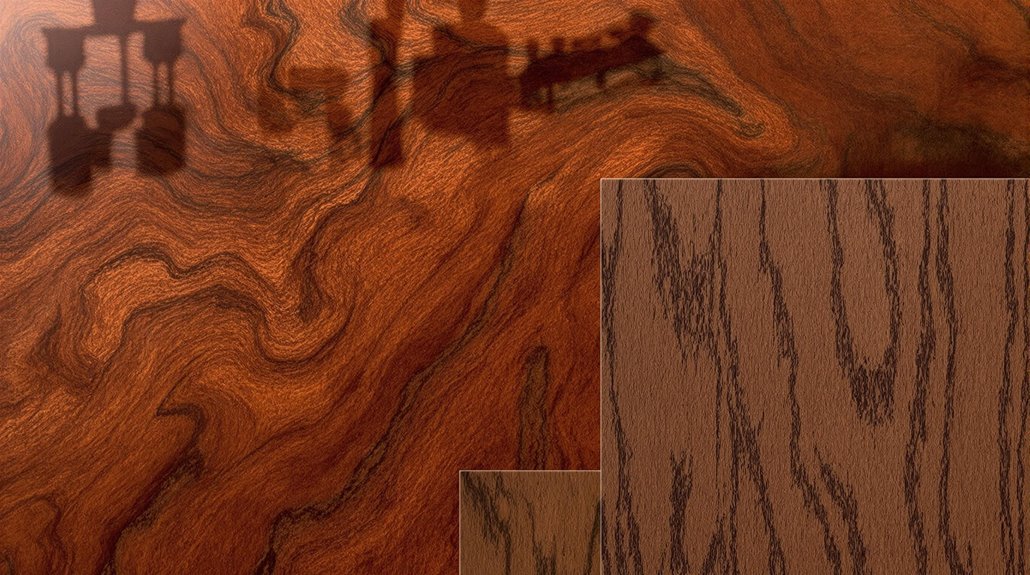The highest quality furniture is typically made from hardwoods, including walnut, maple, mahogany, and cherry. These woods are favored for their durability and aesthetic qualities, making them ideal for high-end furniture. For example, walnut offers rich color tones and a Janka hardness rating of 1,010, while hard maple is known for its resilience with a Janka rating of 1,450. Mahogany's fine grain allows for intricate designs, enhancing craftsmanship. Additionally, environmental sustainability in sourcing these woods is increasingly important. Understanding specific wood characteristics is vital for selecting the best materials for furniture construction. Further insights into wood types follow.
Overview of Quality Woods
Quality woods play an essential role in crafting durable and aesthetically pleasing furniture. Various hardwoods, such as walnut, maple, oak, mahogany, and acacia, are recognized for their strength and versatility. Walnut, with a Janka rating of 1010, is valued for its unique dark color and tight grain, making it ideal for high-quality furniture. Maple, particularly hard maple, boasts a Janka rating of 1450, providing durability for flooring and kitchen accessories. Oak, known for its exceptional durability with a white oak rating of 1360, is frequently employed in cabinetry and flooring. Mahogany offers a rich reddish-brown hue with a Janka score of 800-900, while acacia, rated at 1750, is favored for both indoor and outdoor furniture due to its resilience.
High-End Hardwoods
High-end hardwoods are distinguished not only by their remarkable hardness and density but also by their exceptional aesthetic appeal. For instance, Brazilian walnut ranks highest on the Janka hardness scale at 3,684 lbs, while hickory is renowned among commonly used hardwoods for its strength. Ebony and mesquite, with hardness ratings of 3,220 lbs and 2,345 lbs respectively, further exemplify this category. Aesthetically, woods like walnut and cherry are prized for their rich colors and fine grains, while maple is favored for its smooth texture. Teak, with its unique grain patterns, is another popular choice. High-end hardwoods not only elevate the visual appeal of furniture but also signify quality craftsmanship, making them sought-after materials for discerning consumers.
Durability and Workability
The selection of hardwoods for quality furniture not only emphasizes aesthetic value but also highlights considerations of durability and workability. Hardwoods, with their higher density and stronger structure, generally outperform softwoods regarding durability. For instance, teakwood is renowned for its resistance to the elements, making it ideal for outdoor applications. Brazilian Walnut, with a Janka hardness rating of 3,684 lbs, exemplifies exceptional wear resistance. Additionally, species like white oak and maple exhibit remarkable stability, which is essential in furniture construction. Regarding workability, hardwoods such as mahogany and walnut facilitate intricate designs due to their favorable grain patterns. The superiority of seasoned hardwoods enhances both their structural integrity and ease of manipulation, making them preferred choices for quality furniture.
Aesthetic Appeal
The aesthetic appeal of wood in furniture is greatly influenced by its rich color variations, unique grain patterns, and timeless beauty. Different wood species, such as cherry and walnut, showcase a range of hues that can enhance the overall ambiance of a space, while distinctive grain patterns like birdseye and quilted add depth and character. Ultimately, the combination of these attributes not only elevates the visual interest of furniture pieces but also contributes to their enduring elegance in design.
Rich Color Variations
While many factors contribute to the aesthetic appeal of quality furniture, rich color variations in hardwoods play a pivotal role in enhancing its visual charm. Walnut, with its deep, rich brown tones and occasional purplish hues, is highly sought after for its luxurious appearance and high-gloss finish. Cherry wood offers a color range from creamy white to rich reddish-brown, deepening over time, which adds timeless elegance to furniture. Mahogany is known for its reddish-brown hue that darkens with age, paired with a straight grain ideal for durable pieces. Finally, ebony's near-black color with brown streaks makes it exceptionally rare and desirable, achieving a high-gloss finish perfect for intricate carvings and fine detail work, further elevating furniture aesthetics.
Unique Grain Patterns
Unique grain patterns in hardwoods serve as a hallmark of exceptional craftsmanship, greatly enhancing the aesthetic appeal of quality furniture. For instance, oak features straight or coarse grains with distinctive rays, while walnut showcases wavy grains often adorned with burl patterns. Mahogany exhibits an interlocked grain that produces a ribbon-like effect, contributing to its luxurious appearance. Ash presents pronounced grains with cathedral-like arches, and maple can feature fine, straight grains or more intricate patterns such as birdseye and quilted. These unique characteristics not only provide visual interest but also allow for diverse design applications, from rustic charm to modern minimalism. As each piece of wood is unique, these grain patterns guarantee that no two furniture items are alike.
Timeless Beauty and Elegance
Each piece of solid wood furniture embodies timeless beauty and elegance, elevating any interior space. The natural aging process of solid wood contributes to its appeal, as it develops a unique patina and subtle color changes that enhance its character over time. This organic evolution adds warmth and personality, reflecting the rich history of each piece. Versatile in design, solid wood complements both modern and traditional aesthetics, allowing for a range of styles from minimalist to rustic. Additionally, its authenticity provides an unmatched depth, ensuring each item is not just functional but also a work of art. Choosing solid wood furniture aligns with sustainable living principles, fostering a connection to nature while promoting environmentally friendly practices.
Common Uses in Furniture
Wood serves as the foundation for quality furniture, with various species offering distinct characteristics that cater to diverse design needs and preferences. Hardwoods such as walnut, cherry, and mahogany are frequently employed for high-end furniture due to their durability and aesthetic appeal. Walnut, with its unique dark color and tight grain, is commonly used for tables and dressers. Cherry, known for its elegant color variations, is favored for cabinetry and paneling. Meanwhile, mahogany, with its historical significance, is often utilized in antique reproductions. Softwoods, like pine and cedar, provide affordable options for casual furniture designs, while exotic woods such as teak and rosewood are sought after for their rarity and luxurious appeal, serving various applications in both indoor and outdoor settings.
Budget Considerations
Budget considerations play an essential role in the selection of quality furniture, particularly when it comes to the type of wood and craftsmanship involved. Hardwoods, such as oak, maple, walnut, and mahogany, are typically more expensive due to their density and slower growth rates. While mahogany and walnut are sought after for luxurious furniture, options like red oak and maple can provide more affordable alternatives. Additionally, larger furniture pieces and those with intricate designs greatly increase costs, as do advanced construction techniques. Investing in solid wood furniture may require a higher initial expenditure, but its durability offers long-term value, reducing the frequency of replacements and repairs. Therefore, careful budgeting is vital for making informed furniture purchases. Furthermore, retailers can benefit from bulk purchasing to maximize their investment in high-quality furniture.
Environmental Sustainability
Environmental sustainability in furniture production hinges on sustainable sourcing practices, the selection of eco-friendly wood options, and the critical issue of deforestation. By prioritizing wood from certified sources like the Forest Stewardship Council (FSC) and embracing fast-growing species such as bamboo and mango wood, manufacturers can greatly mitigate their ecological footprint. Additionally, addressing the impacts of deforestation through responsible forestry not only preserves biodiversity but also supports the long-term viability of our planet's resources.
Sustainable Sourcing Practices
Considering the increasing demand for eco-friendly products, sustainable sourcing practices have become essential in the furniture industry. Certification from organizations such as the Forest Stewardship Council (FSC) or the Programme for the Endorsement of Forest Certification (PEFC) guarantees wood originates from responsibly managed forests. These certifications are verified through third-party audits, creating transparency and accountability in the supply chain. Ethical procurement focuses on partnering with manufacturers who prioritize sustainability, while thorough audits help identify sourcing challenges. Implementing a sustainable procurement policy involves defining objectives and criteria for timber sourcing. Additionally, leveraging technologies like blockchain enhances traceability, guaranteeing that all stages, from harvesting to final product, adhere to sustainability standards, ultimately supporting environmental and community well-being.
Eco-Friendly Wood Options
How can furniture manufacturers align quality with sustainability? Eco-friendly wood options, such as bamboo, reclaimed wood, and sustainable hardwoods, offer viable solutions. Bamboo, a rapidly renewable resource, is harvested every 3-5 years, showcasing strength and versatility. Reclaimed wood, salvaged from older structures, not only conserves natural resources but adds a unique character to furniture. Sustainable hardwoods, like oak and teak, provide durability and aesthetic appeal, with many options available as FSC-certified. Additionally, materials like acacia, parawood, and eucalyptus are recognized for their resilience and minimal environmental impact. Cork, harvested sustainably, contributes to carbon sequestration and insulation. By utilizing these eco-friendly alternatives, manufacturers can produce high-quality, sustainable furniture while minimizing their ecological footprint.
Impact of Deforestation
As deforestation continues to reshape global landscapes, its profound impact on environmental sustainability becomes increasingly evident. Each year, approximately 10 million hectares of forest are lost, primarily due to agriculture and wood production. Since 1990, 420 million hectares have vanished, with tropical forests bearing the brunt, as 96% of deforestation occurs in these biodiverse regions. This loss contributes to roughly 4.8 million tonnes of carbon dioxide emissions annually, considerably affecting global climate stability. Additionally, the destruction of these ecosystems threatens countless species and disrupts essential ecological functions. Although deforestation rates have declined since the 1980s, the ongoing loss necessitates urgent global action to mitigate environmental degradation and promote sustainable forest management practices.
Maintenance and Care
Proper maintenance and care are essential to preserving the beauty and longevity of quality wooden furniture. Regular dusting with a soft, dry cloth or microfiber cloth prevents dust accumulation and scratches, while a soft-bristle brush can reach intricate carvings. Cleaning solutions should consist of mild dish soap mixed with warm water or a vinegar-water solution to safely remove residues. Avoid harsh chemicals that can harm finishes. For stains, non-gel toothpaste, baking soda paste, or rubbing alcohol can effectively address specific issues. Preventive measures include using felt pads under furniture legs, coasters to avoid water rings, and maintaining stable humidity levels. Annual application of suitable polish nourishes the wood, ensuring enduring appeal and functionality. Regular inspections are vital for timely care.
Comparing Wood Types
Maintaining the beauty and functionality of quality wooden furniture relies heavily on the choice of wood type. Each wood variety offers distinct characteristics that influence durability, aesthetics, workability, and cost. For instance, hard maple, with a Janka rating of 1450, is renowned for its strength and versatility in high-end applications, while white oak, rated at 1360, excels in cabinetry and flooring. Walnut, valued for its unique dark hues, provides durability but comes at a premium price. Teak, resistant to decay, offers both outdoor and indoor applications, whereas rosewood, although extremely durable, is rare and costly. Cherry and mahogany present rich aesthetics but are both limited in availability, affecting their market price considerably. Each wood type must be evaluated for specific furniture needs.
Final Recommendations
When selecting wood for high-quality furniture, prioritizing durability, aesthetic appeal, and sustainability is essential. Hardwoods such as oak, maple, walnut, and cherry are recommended for their strength and rich visual characteristics. Oak, particularly, is known for its resistance to wear, while maple is perfect for high-use areas due to its sturdiness. Walnut's dense properties and cherry's unique beauty make them valuable choices. It is vital to source wood sustainably from local forests, as this reduces carbon emissions and supports environmental responsibility. Additionally, the use of solid lumber and time-tested joinery techniques enhances furniture durability. Customization options further allow for personalization in design, providing various styles that cater to individual tastes while maintaining a commitment to quality and longevity.

